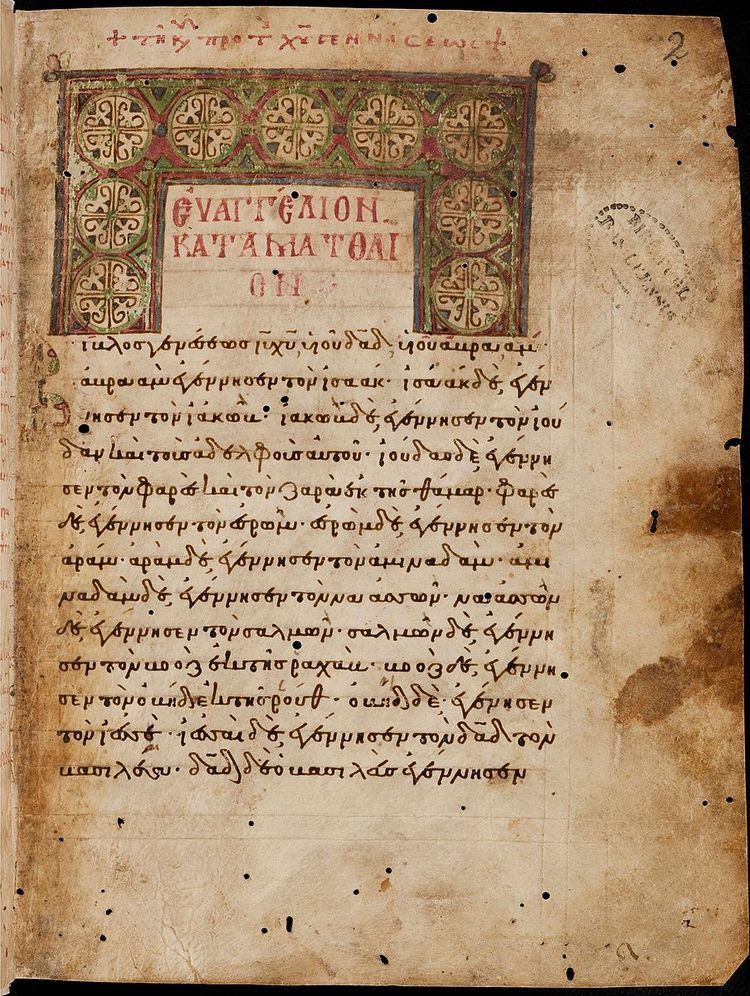Date 11th/12th century Size 19.5 cm by 15.2 cm Category V | Now at University of Basel Type Byzantine text-type Script Greek language | |
 | ||
Name Codex Basiliensis A. N. IV. 1 Similar Novum Instrumentum omne, Codex Regius, problem of the New Testamen, The text of the New Testament, Codex Bezae | ||
Codex Basiliensis A. N. IV. 1, known as Minuscule 2 (on the Gregory-Aland), ε 1214 (in Soden's numbering), is a Greek minuscule manuscript of the New Testament, dated palaeographically to the 11th or 12th century. It was used by Erasmus in his edition of Greek text of the New Testament and became the basis for the Textus Receptus in the Gospels. The manuscript has complex contents.
Contents
Description
The codex contains a complete text of the four Gospels on 248 parchment leaves with size 19.5 cm by 15.2 cm (text only 13.6 cm by 9.9 cm). The text is written in 1 column per page, 20 lines per page, in minuscule letters and contains ornaments in colour, the initial letters in red.
The text is divided according to the κεφαλαια (chapters), whose numbers are given at the margin (not in John), and their τιτλοι (titles of chapters) at the top of the pages. There is also another division according to the smaller Ammonian Sections. Matthew is divided into 359, Mark – 240, Luke – 342, and John into 231 Ammonian Sections (common accepted number of the Ammonian Sections: 355, 235, 343, 232). There is no references to the Eusebian Canons.
The tables of the κεφαλαια (tables of contents) are place before each Gospel and subscriptions at the end of each Gospel. Some leaves of the codex were lost, but the text of the Gospels has survived in complete condition.
Text
The Greek text of the codex is a representative of the Byzantine text-type. Hermann von Soden classified it to the textual family Kx. Aland placed it in Category V. Hermann von Soden classified it to the textual family Family Kx. According to the Claremont Profile Method it has mixed Byzantine text in Luke 1. In Luke 10 and Luke 20 it represents Kx.
In Luke 6:28 it lacks phrase προσευχεσθε υπερ των επηρεαζοντων υμας. It was added by one of correctors in the lower margin.
In John 8:6 it used textual variant μη προσποιουμενος, erased by corrector. Τhis variant have also the manuscripts 07, 011, 017, 028, 041, and majority of the Byzantine manuscripts. It is not included by the manuscripts 021, 028, 030, 036, 045, 047, 7, 8, 9, 196, 461c2, 1203, 1216, 1243, 1514, ℓ 663. Erasmus did not use this phrase in his Novum Testamentum.
History of the codex
The early story of the manuscript and its provenance is unknown. The codex was bought by monks at Basel for two Rhenish florins. Since 1559 it was held in the University of Basel. Its later story is the same as that of Codex Basilensis and Codex Basilensis A. N. IV. 2.
Desiderius Erasmus received this codex from the Dominican monks at Basel, and chiefly used it as the basis for the Gospels portion of the first edition of his Novum Testamentum (1516), with press corrections by his hand, and barbarously scored with red chalk to suit his page format. Robert Estienne did not directly consult this manuscript in his Editio Regia (1550), but since his edition was based on the Erasmian text, 2's readings became a basis for the Textus Receptus.
Martin Crusius used this manuscript in 1577. The manuscript was examined by Bengel (codex β), Wettstein, Burgon, Hoskier, Gregory. According to Bruce M. Metzger it is one of the inferior manuscripts used by Erasmus. Wettstein gave for it number 2 on his list. This siglum is still in use.
The codex is located now at the Basel University Library (A.N. IV. 1) at Basel.
